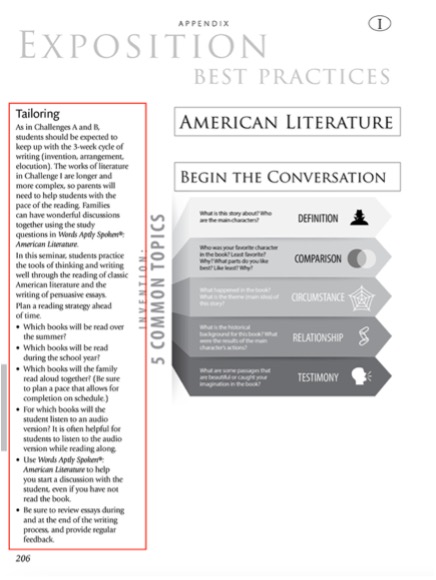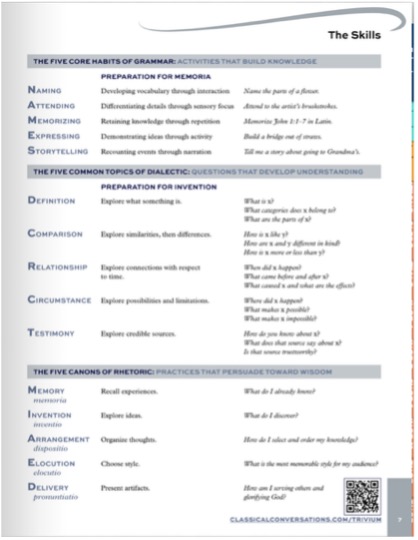In the world of homeschooling, where flexibility is both a blessing and a responsibility, a quiet question often lingers in the minds of parents: Am I helping my child or unintentionally hindering them? This search for clarity leads many parents to explore academic integrity in homeschooling—not merely as a set of rules but as a reflection of virtue, trust, and long-term growth.
Homeschool families often operate without external academic oversight. That freedom allows us to tailor our children’s education in beautiful and effective ways—but it also opens the door to subtle compromises. Skipping hard assignments, inflating grades, or doing work on our child’s behalf can feel like mercy in the moment, but these choices can lead to long-term academic and spiritual harm.
At Classical Conversations, we believe education is about more than grades or credentials. It’s about seeking truth, goodness, and beauty—and helping students grow in wisdom and virtue. That means customizing schoolwork to meet a child’s needs without compromising their character.
Having homeschooled for over twenty years, CC Academic Advisor, Deborah Switzer, understands the tension: How do we faithfully tailor schoolwork without abandoning the training ground of integrity?
Let’s explore how we can protect and promote academic integrity while still personalizing the learning journey.
The Art of Tailoring Schoolwork in Homeschool
I have four children, and at the change of every season, I find myself standing in front of their closets, wondering what items still might fit and which are outgrown. It astounds me that within just a few months, each child could change so drastically that the clothing I was confident would fit was now too small.
While each of my children followed a general growth pattern during the teen years, each still had a unique body design that required certain sizes and patterns to suit his or her individual shape and style.
The Clothing-Curriculum Connection
In many ways, tailoring our children’s education is like customizing their clothes closets. As parents, we may need to stand in front of our children’s “educational closets” and begin to ask:
- “Does this outfit still fit?”- Study patterns must evolve as students develop academically.
- “Perhaps he needs this shirt in a different size?”- Curriculum difficulty should match current ability, not age or grade level.
- “How might I adjust this hemline to match my child’s new height?”- Assignments should grow in complexity alongside student capabilities.
To help our children find the true, the good, and the beautiful, we need to adjust and customize their education in a way that suits them while maintaining academic integrity in homeschool.
Each Challenge program curriculum provides the basic “size chart” that our students follow, but not all teens grow at the same rate. Some students may need less complex material, while others require more advanced content. Some benefit from simplified approaches to learning objectives, while others thrive with more elaborate and detailed instruction methods.
Our job as homeschool parents is to tailor our children’s education to fit the current shape and size of their learning journey, without compromising educational standards.
Listen to The Challenge or Challenge with the Everyday Educator podcast.
Defining Academic Integrity in the Homeschool Context
Before diving into tailoring techniques, let’s establish what academic integrity means in a homeschool setting. Academic integrity encompasses honesty, responsibility, and ethical conduct in educational pursuits. In homeschooling, this includes:
- Ensuring work represents the student’s genuine effort and understanding
- Providing appropriate guidance without doing the work for our children
- Documenting adjustments transparently for accountability
- Teaching proper citation and research methods
- Maintaining appropriate assessment standards even when customizing
As homeschool parents, we hold a unique position as both parent and teacher. This dual role requires careful boundaries that support learning while maintaining ethical homeschool help. The goal is to tailor education to fit our children’s needs while preparing them for a world that will expect certain standards of integrity.
Finding the Right Size: Adjusting Without Compromising
As our students work through the Challenge curriculum, we might find that their size changes before we’ve even had time to notice. Has this ever happened to you? You walk down the hallway, and suddenly you notice that your son’s pants are now highwaters, but you were certain they fit last week!
The same goes for education: one week, your student may comprehend a reading assignment perfectly, and the next week, he might struggle significantly because he needs additional vocabulary support. It’s time to modify your approach and provide more guidance.
There are two main ways to adjust Challenge assignments to better meet your student’s needs: modifying the amount of work and adjusting the pace of work.
Adjusting Assignment Amounts with Integrity
There may be weeks when the assignment load is too heavy, and weeks when more can be added. You know the amount of work that best suits your child. Each week, look at the guide and consider your family dynamic. Ask questions like, “Do we have a busy week? Are there life circumstances that call for me to adjust the assignments? Do we want to conduct some extra research on an author or topic this week?”
Remember, the guide is exactly that … a guide!
Practical Examples of Ethical Modifications
I’m a checklist mama, and I get a dopamine rush every time I check one of those boxes in the guide. But I have learned that tailoring is necessary, and I have happily adjusted all my children’s assignments over the years. Here are a few ways I’ve had my students adjust their work while maintaining academic integrity:
- Write essay outlines instead of complete essays, with thorough research still required
- Listen to audiobooks during travel time, with discussions to ensure comprehension
- Allow open-book science assessments that focus on application over memorization
- Choose selected math or Latin problems that demonstrate concept mastery
- Assign targeted research on topics of interest to deepen engagement
- Require advanced essay formats for students ready for greater challenges
There are so many ways to adjust the amount of work. Talk to your Tutor or families in your community and brainstorm ideas to find the perfect fit for you!
Adjusting Pace While Maintaining Community
Adjusting the pace of assignments can get tricky because our students still need to participate in conversations during community day. A question often lingers in the back of a parent’s mind: “If I adjust the pace, won’t my child be out of sync with the rest of the students?”
The beauty of community is that we all learn from each other. Numerous times, I have slowed down the pace of my child’s reading. For example, to really absorb what was being taught in the logic text in Challenge B, we took a slower pace than the guide. We communicated with our Tutor and then participated with what we did know. Then, as students shared new information in the community, it served as a preview.
No matter where students are in their studies, our local communities want students to come and feel part of the conversation. If you need to move a bit slower, that’s ok! Communicate with your Tutor and walk at a pace that best suits your student.
Tailoring Tips in the Challenge Guide
One practical tool to help tailor our students’ education is to check the Challenge guide. The appendices of every guide has suggestions in each strand that offer helpful hints on how to find the right fit for your student. Here’s an example of the Challenge I Exposition appendix: note the tailored advice for reading. Being familiar with these tailoring tips helps you prepare for the upcoming academic year.

Read about Homeschool Education that Pays Off: Benefits of Challenge
Addressing Homeschool Cheating Concerns
When tailoring schoolwork, parents sometimes worry: “Am I making it too easy? Is this considered ‘cheating’ the system?” This concern reflects a healthy awareness of academic and moral standards. The key difference between helpful tailoring and compromised integrity lies in the end goal: Are adjustments helping your child master the material, or simply avoiding difficult work?
Ethical adjustments should:
- Target the learning objective or skill, even if it differs from the guide
- Require genuine effort from the student
- Result in authentic learning and skill development
- Be documented and justified educationally
Using this type of criterion helps represent responsible tailoring rather than shortcuts around learning.
Pro Tip: Be Proactive
Summer is a great time to think about tailoring. Consider your students’ strengths and make unhurried decisions that will mark stability and growth for the upcoming year.
Finding the Right Style: Adjusting Approach Without Compromising Standards
Sometimes, as parents, we must adjust our educational focus to develop lifelong learners. Emphasizing the Fifteen Skills (page 7 in the CC catalog) helps cultivate classical learning abilities. Your student might manage workload and pace well, but struggle with assignment style.

While all Fifteen Skills are important, learning is a lifelong journey. Some days require stretching your student to try on more formal “educational attire” they wouldn’t normally choose, while other days allow for comfortable “learning sweatpants” that give them freedom to explore in more relaxed ways.
Here are some examples to help your student stretch their learning skills. If your student has:
- Strong vocabulary but poor paper organization – Assign thorough outlines to practice the canon of Arrangement
- Natural talent for defining terms – Allow focus on the topic of Definition rather than research to build on strengths
- Tendency to skip brainstorming before speeches – Use ANI charts to develop skill of Invention
Creating Alternative Assessments with Integrity
I remember adjusting my daughter’s biology studies in Challenge II. She struggled with test-taking, and I quickly recognized that the typical tests in the textbook were not a good fit for her. So, did I throw out assessment altogether? Not at all. As Marc Hays said in his article on tailoring,
“A classical and Christian education is founded on the principle that a proper, human education should conform its students to a standard outside of themselves. Both teacher and student are under an ideal greater than themselves.”
It would have been easy to throw out the assessment portion of biology, but it would not have developed virtue in my daughter. We created tailored assessments using oral narration and home presentations to showcase learning. She also kept a detailed lab journal and wrote formal lab reports.
Her assessments revolved around her astutely creating presentations, sharing biological concepts, and making connections to scripture. It was challenging and a stretch …and she thrived. We learned to tailor the content to develop rhetorical skills rather than quizzing and test-taking.
What adjustments to style can you make in your student’s education? What skills do you want to develop to help your child flourish? Take time to think through the Fifteen Skills and consider ways to emphasize the practice of classical skills rather than the mastery of content.
Homeschool Parent Support Boundaries: Ethical Help vs. Doing the Work
As homeschool parents, we should establish clear boundaries between supporting our children’s learning and doing the work for them. Here are suggestions for providing ethical homeschool help:
- Scaffolding vs. Substituting: Provide frameworks, guiding questions, and resources, but require students to complete the actual thinking and writing.
- Documentation of Adjustments: Keep records of your adjustments, noting why they were appropriate for your child’s learning needs.
- Gradual Independence: As students mature, gradually reduce the level of assistance to foster academic self-reliance. We see this happen naturally in the three tours of Essentials.
- Teaching Proper Citation: Ensure your student understands how to properly attribute sources and ideas, an essential skill for academic integrity when writing research papers.
- External Validation: Occasionally use third-party evaluations, such as the CLT tests, to verify that your tailored approach results in genuine learning outcomes.
Having these boundaries not only maintains academic integrity but also prepares your child for future educational environments where independent work will be expected.
Here is Your Guide to the Challenge Program
Maintain Essential Elements While Tailoring
A well-organized educational approach, like your child’s wardrobe, brings clarity and purpose. However, we must ensure that core components remain intact while tailoring. Just as we wouldn’t send our children outside without pants, we shouldn’t eliminate essential learning skills or subjects like Latin entirely. Instead, we adjust the quantity and difficulty of Latin exercises to suit our students’ learning level, but the topic itself remains non-negotiable.
We must also reassess educational “hand-me-downs.” Teaching methods that worked perfectly for one child may be ill-suited for another. The Latin approach that succeeded with your older child might need significant adaptation for your younger student. Be willing to discard educational methods that don’t fit and find alternative approaches that honor your child’s unique learning style.
As Psalm 139:14 reminds us, “I praise you because I am fearfully and wonderfully made.” Our joy as parents is discovering these unique learning styles and helping our children excel in their classical education.
Modeling Integrity: Teaching By Example
Perhaps the most powerful way to instill academic integrity in your homeschool is by modeling it yourself.
- When you’re unsure about a concept, show your children how you research and learn.
- Acknowledge when you make mistakes.
- Demonstrate proper citation when you share information.
This authentic approach teaches children that integrity isn’t just about following rules—it’s about approaching learning with honesty and respect.
Have open conversations with your children about why academic integrity matters. Explain that it’s not just about avoiding “cheating,” but about developing character and genuine learning. These discussions prepare them for a lifetime of ethical decision-making in their educational and professional pursuits.
Key Takeaways: Academic Integrity in the Tailored Homeschool
- Tailor schoolwork with integrity.
Adjust the curriculum to fit your child’s needs while preserving honest effort, academic growth, and virtue. - Know the difference between helping and doing.
Support learning through scaffolding and guidance, not by completing work for your child. - Customize assignments, not core content.
Modify the pace, workload, and style of learning while maintaining essential skills and subjects. - Prioritize classical learning skills.
Use adjustments to strengthen your child’s reasoning, organizing, and presenting abilities, not just content mastery. - Model integrity and humility.
Demonstrate ethical learning habits and openness in your own studies to inspire lifelong integrity in your child.
Academic Integrity in Your Homeschool
While it feels wonderful to create an organized closet full of clothes that fit, the process of getting to that point can be quite messy. When I organize my child’s closet, I have bags of clothes scattered across the floor. Sometimes I sit on the floor and say, “It’s not worth it! I’m just going to throw it all away.” But as I pray and ask the Lord for help, He guides me and helps me find the right fit for my children.
In our homeschool journeys, each task or assignment has its purpose for our students … but it also has purpose in our own souls. Tailoring education is hard work, but it is worth it. Amid the mess, God meets us and gives us the strength and strategy to properly equip our children with the skills they need for their futures.
Maintaining academic integrity while providing customized education isn’t always straightforward, but it teaches our children that we value their individual needs and broader educational standards.





